How steroids were a double-edged sword for Major League Baseball
- John Butler
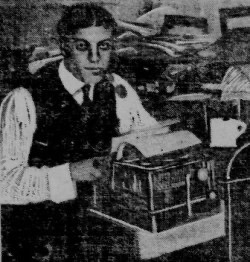
- Apr 24, 2020
- 9 min read
Updated: Jul 21, 2021
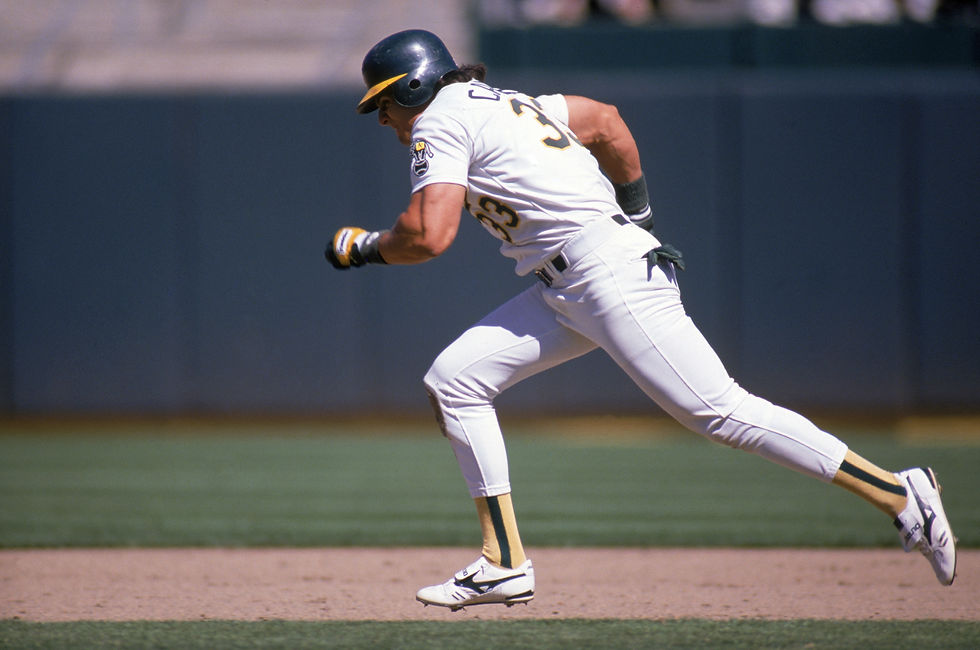
José Canseco played with the Oakland Athletics from 1985-1992 and 1997 where he had his most successful seasons, which included winning the 1988 AL MVP Award after bashing 42 bombs and swiping 40 bags. In 2005, Canseco wrote his controversial memoir Juiced, admitting he used steroids and ratted out other players who he suspected doing it as well. Photo by Otto Greule Jr/Getty Images.
Written by Jack Butler jbutle58@lakers.mercyhurst.edu
CLEVELAND, Ohio – It has been 18 years since the end of the Steroid Era in Major League Baseball where currently in 2020 each year all thirty teams collectively break the single-season home run and strikeout records. From 1993 to 2002 some of the games well-known ball players – Mark McGwire, Sammy Sosa, Rafael Palmeiro, Roger Clemens, Barry Bonds, and the notorious José Canseco – were injecting themselves with steroids and/or human growth hormones (HGH) to get stronger and back on the field faster. This allowed them to achieve feats that fans and journalists alike thought would never be broken. These included the single-season home run record, win the National League Cy Young Award at the age of 41, and 40-40 seasons, meaning stealing 40 bases and hitting 40 dingers in the same campaign. Canseco accomplished this in 1988 where he won the Most Valuable Player Award while also leading the Oakland Athletics to their first of three consecutive World Series appearances but they lost to the Los Angeles Dodgers in five games. However, many questioned where Canseco got his strength and speed. The answer was steroids. With the help of using banned substances in 1989, he led Oakland back to a World Series and this time swept the San Francisco Giants. After winning a title for the first time in fifteen years, Oakland went to another Fall Classic in 1990 but were swept in four by the Cincinnati Reds.
The reign for the Athletics came to a halt when the Minnesota Twins went from last to first place to become World Champions in 1991 over the up and coming Atlanta Braves in a historic seven games. Before the strike stopped baseball, the Toronto Blue Jays claimed back to back Fall Classics in 1992 and 93 which was the first and only Canadian franchise in Major League Baseball to be atop of the sport.
When then acting Commissioner Allan Huber “Bud” Selig announced in mid-September 1994 that the season would not be completed which meant no World Series for the first time in nine decades fans all around the world were devastated after hearing the news. The strike continued into 1995 until owners accepted their unconditional agreement to return to work on April 2, which three days prior a judge declared an injection of the expired agreement. This resulted in having the latest start date for an MLB campaign on April 25 and spectators were protesting the strike that saw a significant decline in attendance as well.
So how do you generate public interest after the worst eight months in the history of baseball? Well, let’s see, you don’t implement mandatory drug testing giving players the chance to get their hands-on steroids even though the substances were banned under baseball’s drug policy by Commissioner Fay Vincent in June 1991 to start a home run chase.
In 1998, McGwire and Sosa provided just that and more with the most exciting regular season to date when both sluggers set out to break a 37-year-old home run record set by Roger Maris in 1961 when the Yankee great hit 61 homers. McGwire moved ahead of Maris by launching number 62 on September 8 at Busch Stadium II and finished with an astonishing 70 homers while Sosa blasted 66. At the time fans did not suspect anything about steroids or performance-enhancing drugs to break the record and they celebrated the accomplishments. Also, they were clueless about what the players were doing to themselves and others in the clubhouses before games to improve their performance.
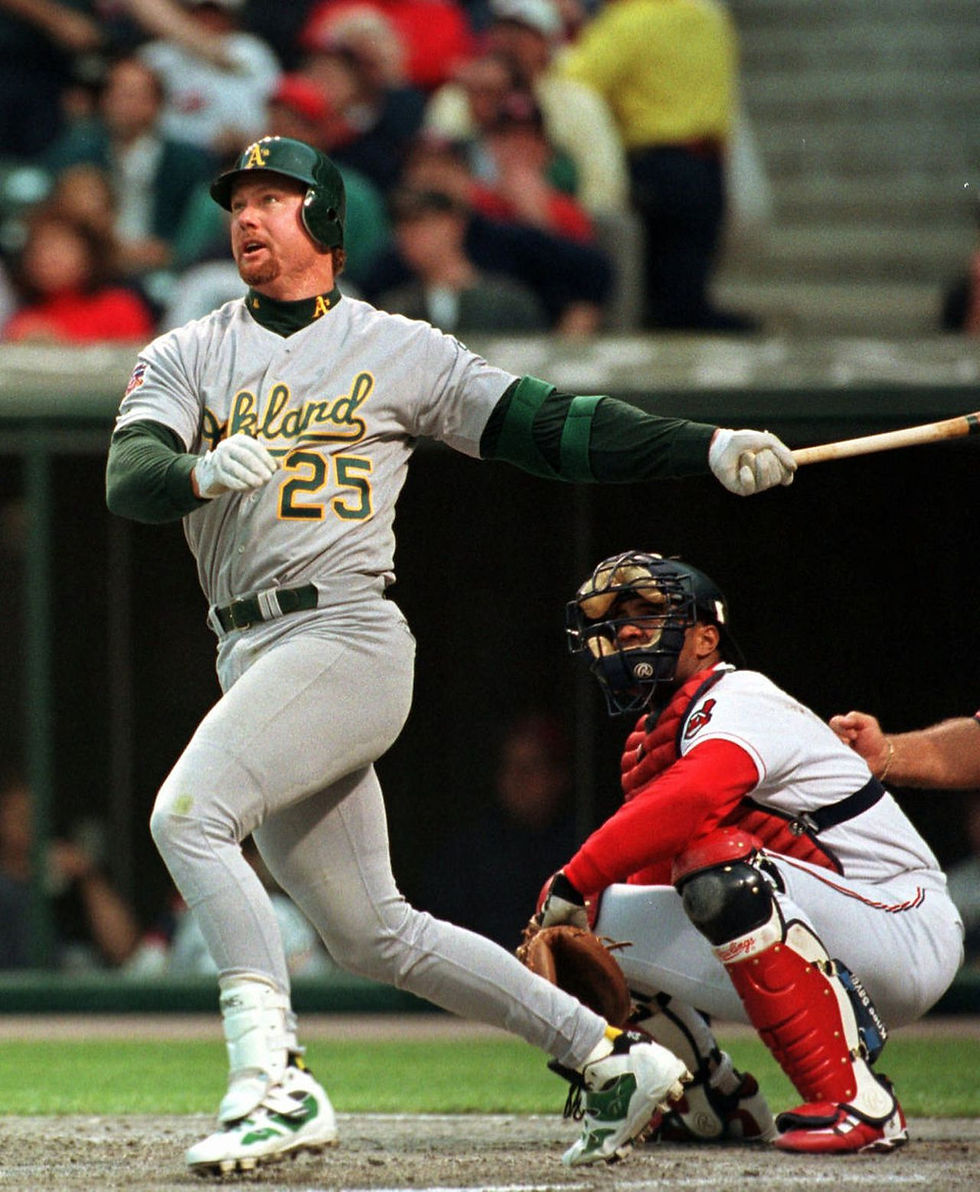
Mark McGwire, the former Oakland Athletics first baseman, watches a ball he hit off Cleveland Indians veteran right-handed starter Orel Hershiser to the top of the bleachers at Jacobs Field in Cleveland, Ohio. Photo by Mark Duncan, Associated Press.

Former Chicago Cubs right fielder Sammy Sosa who played with the organization from 1992-2004 finishes a swing versus the Milwaukee Brewers. Photo by MLB.
Just three years later, star San Francisco slugger and left fielder Barry Bonds broke the single-season record set by McGwire by clobbering over 70 dingers. Bonds reached that number with a little help from steroids. It all started back after the 1998 season during the winter when he first worked out with trainer Greg Anderson who hung out in local gyms and was a low-level steroid user and dealer. Anderson also introduced Bonds to steroids, which the then 3-time NL MVP took on a regular basis.
After missing a third of the 1999 season due to stressing his elbow so much that he tore his triceps, Bonds smashed 49 homers in 2000 but he was just getting started. In 2001, Bonds had the most productive season in his 22-year career, hitting 73 homers, driving in 137, and hit at a .328 clip. This began his phenomenal run of winning four consecutive NL MVP awards, but fans and journalists alike were speculating if his late home run surge was linked to PED usage. The reason was that Bonds was between the ages of 37-40 when he received MVP honors from 2001-2004 which is usually when player's numbers start to decline not reach its peak.
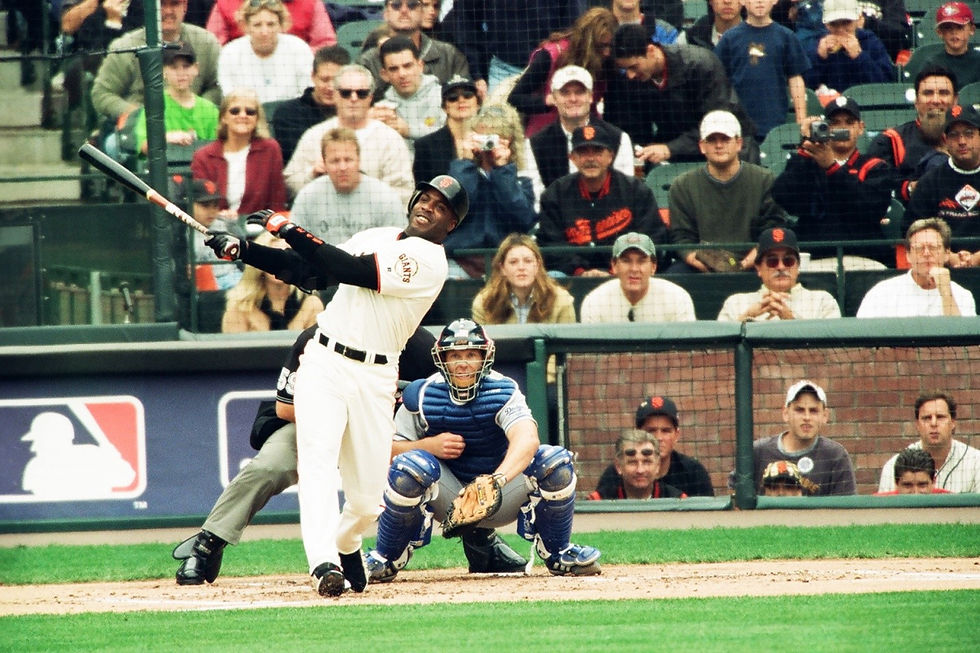
San Francisco Giants legendary outfielder and slugger Barry Bonds smiles as he finishes his swing at Pacific Bell Park, now Oracle Park. Photo by Sporting News/Getty Images.
Even with all the fame and accolades, Bonds earned, one scandal hurt his legacy and controversy become synonymous with the once renowned slugger and outfielder. That scandal was the Bay Area Laboratory Cooperative (BALCO) scandal. Victor Conte had run BALCO where he supplied both legal and illegal PEDs to athletes across the United States for years. According to the Society for American Baseball Research (SABR) player biography of Barry Bonds, it explains that Anderson, Bonds’ trainer, had introduced him to Conte, and when he was questioned, federal agents said Conte admitted to supplying Bonds with multiple steroids. [1] Bonds denied using steroids or any PEDs during the press conference after receiving his sixth MVP award but appeared before a federal grand jury to provide answers to questions under oath about his relationship with BALCO.
The San Francisco Chronicle ran the supposedly secret grand-jury testimony in the paper during December 2004. “Bonds had told the grand jury that he used steroids known as the “clear” and the “cream.” But that his trainer, Anderson, told him that they were flaxseed oil and rubbing balm.” [2] Two months after the San Francisco slugger hit career homer 762 he would be back in the courtroom. In the BALCO case, Bonds gave his grand-jury testimony where he made statements that were unclear about getting steroid injections by Anderson. The prosecutors concluded that he had avoided their questions and was indicted for obstruction of justice and perjury in November 2007. Even though Bonds was convicted on the obstruction charge in 2011, the jury was deadlocked on the perjury charges where they sentenced him to 30 days of house arrest. But in 2015 the conviction got overturned after a series of appeals.
Around the same time as Bonds’ steroid use, the great Roger “Rocket” Clemens was receiving steroid injections from personal trainer Brian McNamee who was the strength and conditioning coach with the Toronto Blue Jays and New York Yankees. In 1997 Clemens inked a deal with the Blue Jays after spending thirteen seasons in a Red Sox uniform.
The Mitchell Report thoroughly details Clemens's professional relationship with McNamee and the multiple times he injected the pitcher with performance-enhancing substances. It all began during the end of a road trip in 1998, or right after the club returned home to Toronto, Clemens came to McNamee and, brought up the subject of using steroids for the first time. He was not able to inject himself, Clemens said and asked McNamee for help.

Roger Clemens pitched for the Toronto Blue Jays from 1997-1998 where he won back-to-back AL Cy Young Awards with or without the steroid injections by personal trainer Brian McNamee. Photo by Toronto Blue Jays and MLB.
Clemens asked McNamee to inject him with Winstrol later that summer, which was supplied by Clemens. Over a several-week period, McNamee injected Clemens roughly four times in the buttocks with needles that Clemens provided. His performance showed remarkable improvement from the time that McNamee injected Clemens with Winstrol.
When Mike Wallace of CBS’s 60 Minutes referred to these statements from the Mitchell Report during an interview with Clemens at his house in Houston, Texas, the “Rocket” furiously exclaimed, “it never happened” [3] (Click this link https://www.youtube.com/watch?v=12OS6X0FO4g to watch Roger Clemens’s interview with Mike Wallace). This phrase continued to be used by Clemens throughout the rest of the conversation.
Two years went by from the first round of injections and the “Rocket” now donned a New York Yankee cap where McNamee joined him because Clemens persuaded the Bronx Bombers to hire him as the assistant strength and conditioning coach. Halfway through the 2000 season, according to McNamee, Clemens made it clear he wanted to use steroids again. McNamee injected Clemens four to six times in the buttocks with testosterone during the end of the regular season from a bottle labeled either Deca-Durabolin or Sustanon 250 that McNamee had received from Kirk Radomski.
After explaining to Clemens, the possible benefits and risks of using human growth hormone, McNamee injected Clemens with HGH during that same time frame. McNamee thought it was possibly his idea that the “Rocket” try human growth hormone. Even though McNamee did not return to the Yankees following the 2001 season, he still trained with Clemens and Andy Pettitte in Houston. After that campaign, Clemens never asked McNamee to inject him with PEDs, and McNamee had no other conversations with Clemens about such drugs.
The “Rocket” played six more seasons, two with New York (AL), three with Houston, and one more in New York in 2007. He officially retired in 2008 but as of 2020 has never come clean about whether he used steroids.
When Clemens was still pitching like an ace for the Houston Astros, José Canseco wrote a memoir called Juiced: Wild Times, Rampant ‘Roids, Smash Hits & How Baseball Got Big revealing his steroid use from 1986 to his final season with the Chicago White Sox in 2001. The book came out on February 21, 2005, which caused troubling times for Americans’ pastime. Canseco ratted out other players such as Miguel Tejada, Rafael Palmeiro, and others that “led to a March 17, 2005 hearing on the issue before the U.S. House of Representatives Committee on Government Reform.” [4]
Alleged and known steroid users and current ballplayers Curt Schilling, Rafael Palmeiro, Mark McGwire, Sammy Sosa, José Canseco, and Frank Thomas via remote answered questions before Congress. Schilling and Thomas were opposers to steroids in baseball and wanted it out of the game. Canseco got a lot of heat for saying it one way in his book to responding differently at the hearing but mostly told the truth. Sosa did not add hardly anything to the committee since he used a translator. Palmeiro lied in front of Congress during his opening statement when Bud Selig suspended him for 10 days for violating the drug policy. The Cuban first baseman and left fielder expressed, “Let me start by telling you this. I have never used steroids, period” [5] (Watch this video: http://www.mlb.com/pa/pdf/jda.pdf to see Palmeiro and McGwire’s answer questions in front of Congress). Lastly, the worst showing at Congress was by McGwire who denied and dodged every question with the same answer. When asked a question about a bottle of Andro in his locker during the 1998 season, McGwire exclaimed, “Well, sir, I’m not here to talk about the past. I’m here to talk about the positive and not the negative about this issue.” [6]
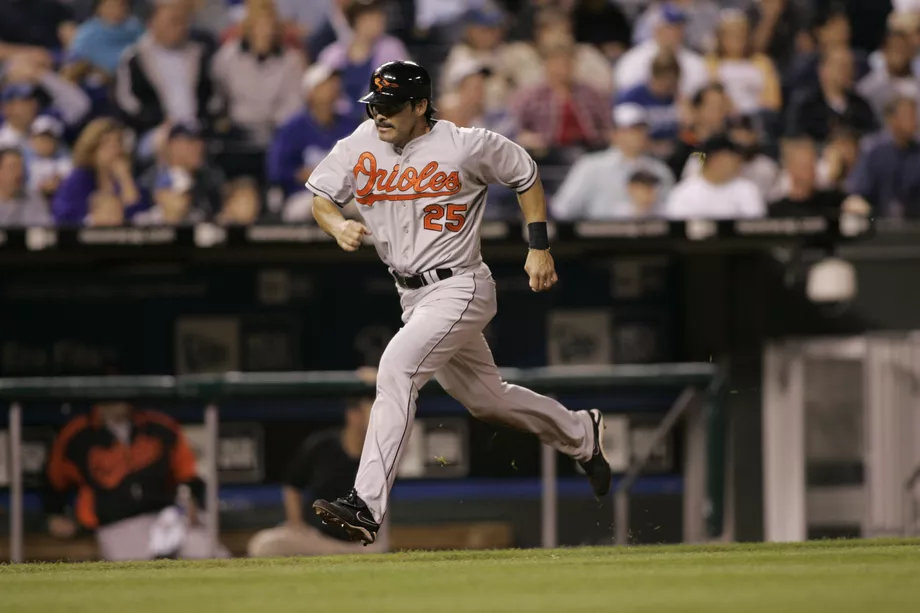
First baseman and left fielder Rafael Palmeiro wore the Baltimore Orioles black and orange for seven seasons from 1994-1998 and 2004-2005. Photo by G. N. Lowrance/Getty Images.
The steroid hearings in 2005 led to George J. Mitchell to spearhead an investigation into MLBs performance-enhancing substances problem. Michell’s Report was released in 2007 and thoroughly examined the history of steroids in baseball, the drug programs throughout the years, and how players were being punished by the Commissioners office. Eventually, after the information coming from the report, Commissioner Selig took immediate action to eliminate the problem from baseball.
According to the Mitchell Report, in 2007, if players who test positive for using steroids and other prohibited substances are subject to a suspension of 50 games, a 100-game suspension for repeat offenders, and a lifetime ban for third offenders without earning pay. [7] Ever since 2014, MLB has had an extremely strict Joint Drug Prevention and Treatment Program. The 2020 Joint Drug Prevention and Treatment Program explains that a player who tests positive will serve an 80-game suspension, repeat offenders 162-game/183-days of pay suspension, and if another offense results in a permanent suspension for MLB and Minor League Baseball. [8] Through the steroid era, players experienced larger than life careers, broke crazy records, hit monster home runs, and ruined chances for non-steroid users for election into the National Baseball Hall of Fame. Nevertheless, MLB has done a fantastic job of turning the sport around where there are so many likable and respectable players in today's game such as Mike Trout, Francisco Lindor, Fernando Tatís Jr., Ronald Acuña, Nolan Arenado, Jacob deGrom, Lucas Giolito and Mike Clevinger.
Endnotes
[1] West, Steve. (2015, Dec. 1). “Barry Bonds.” Society for American Baseball Research. Retrieved April 21, 2020, from https://sabr.org/bioproj/person/e79d202f [2] Fainaru-Wada, Mark and Williams, Lance. Game of Shadows. (Gotham Books, New York, New York, 2006), 71. [3] [the420winner]. (2008, January 7). Roger Clemens on CBS Part 1. [Video file]. Retrieved April 23, 2020, from https://www.youtube.com/watch?v=12OS6X0FO4g [4] See Restoring Faith in America’s Pastime: Evaluating Major League Baseball’s Efforts to Eradicate Steroid Use: Hearing Before the H. Comm. on Gov’t Reform, 109th Cong. 2, 10-11 (2005); see also Letter from Robert D. Manfred, Jr. to Rep. Joseph Barton, Rep. Cliff Stearns and Rep. Nathan Deal, dated Mar. 24, 2005. [5] C-SPAN. (2005, December 28). 2005 Year-In-Review: Baseball & Steroids Hearings. [Video file]. Retrieved April 24, 2020, from https://www.c-span.org/video/?190519-2/2005-year-review-baseball-steroids-hearings [6] Id [7] Major League Baseball’s Joint Drug Prevention and Treatment Program, § 8(H)(2) (2006). [8] Major League Baseball’s Joint Drug Prevention and Treatment Program. (2020). Major League Baseball and the Office of the Commissioner of Baseball. Retrieved April 24, 2020, from http://www.mlb.com/pa/pdf/jda.pdf







Comments